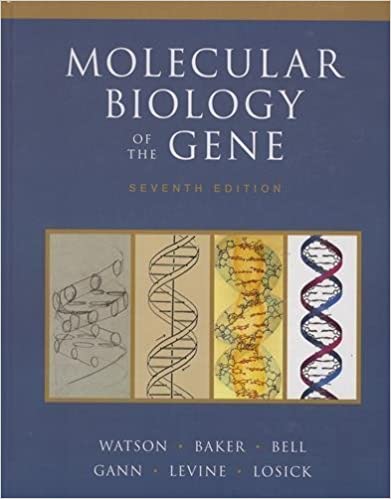
Molecular Biology of the Gene 7th Edition by Richard Losick, James Watson, Michael Levine, Tamara Baker, Alexander Gann
Edition 7ISBN: 9780321762436
Molecular Biology of the Gene 7th Edition by Richard Losick, James Watson, Michael Levine, Tamara Baker, Alexander Gann
Edition 7ISBN: 9780321762436 Exercise 12
The genome of the bacteriophage Q? consists of about 4000 nucleotides of single-stranded RNA. Inside the E. coli host, replication of this genome requires a RNA-dependent RNA polymerase made up of phage and bacterial proteins. Interestingly, the replicase binds to a region in the center of the RNA genome, yet must start copying the 3? end of the RNA template to produce a new strand of RNA in the 5? to 3? direction. Researchers hypothesized that the presence of a predicted pseudoknot in the Q? genome allowed the replicase to gain access to the 3? end of the RNA. To test their hypothesis, they measured the replication efficiency in vitro using wild-type replicase and different versions of the Q? RNA containing mutations in a region key to the predicted pseudoknot formation. They specifically focused on an eight-nucleotide region from the center of the RNA that was complementary to the 3?-terminal hairpin. The wild-type and mutant sequences and replication data are given below.


In vitro replication efficiency (relative to wild type)
Wild type: 100%
Mutant A: 1.6%
Mutant B: 0.6%
Mutant C: 42%
A. Predict why the replication efficiency so low in Mutant A.
B. Predict why the replication efficiency is restored to almost half of wild-type levels in Mutant C?
C. Do you think the results support or refute the hypothesis that the presence of a pseudoknot affects replication?
Data adapted from Klovins and van Duin (1999. J. Mol. Biol. 294 ? 875-884.)


In vitro replication efficiency (relative to wild type)
Wild type: 100%
Mutant A: 1.6%
Mutant B: 0.6%
Mutant C: 42%
A. Predict why the replication efficiency so low in Mutant A.
B. Predict why the replication efficiency is restored to almost half of wild-type levels in Mutant C?
C. Do you think the results support or refute the hypothesis that the presence of a pseudoknot affects replication?
Data adapted from Klovins and van Duin (1999. J. Mol. Biol. 294 ? 875-884.)
Explanation

This question doesn’t have an expert verified answer yet, let Examlex AI Copilot help.
Molecular Biology of the Gene 7th Edition by Richard Losick, James Watson, Michael Levine, Tamara Baker, Alexander Gann
Why don’t you like this exercise?
Other Minimum 8 character and maximum 255 character
Character 255


